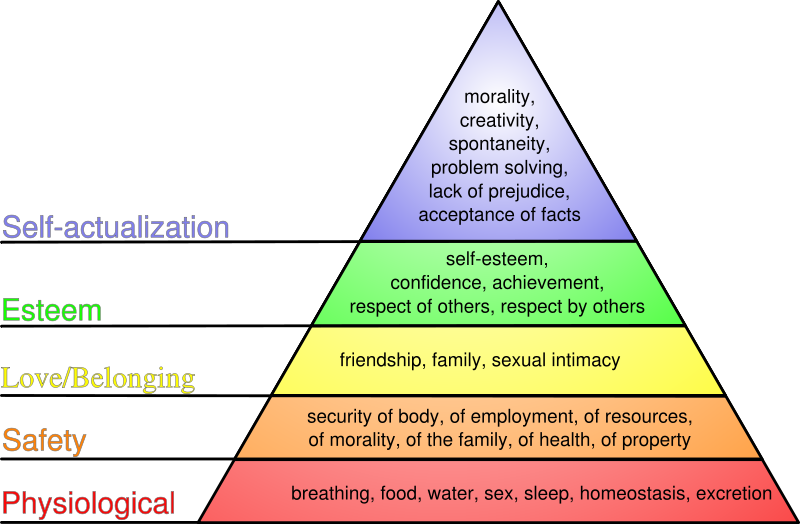by Dina Mehta on 01/12/2010 11:23 0 comments , 2448 views
I was chatting with a friend today who’s not a Twitter user, and trying to explain why I like it, and why so many people do too. I found myself turning to Maslow’s Hierarchy of Needs and his Theory of Human Motivations to try and explain this. I discovered this blog post titled The Hierarchy of Tweets at theInnovation Diaries, with this clever diagram based on Maslow’s model. The author makes an interesting connection between what motivates people and how these needs are expressed in 140 characters:
I also discovered this neat little blog post by students of new media at the University of Amsterdam, where the question discussed is whether Twitter is in fact a tool that nourishes our social needs or is it in fact, increasing our needs to keep track of our friends every minute of the day? Here’s a clip:
Humans are social beings with social needs. We need each other to grow as well. Rom Harré describes in his book ‘Social Being’ that we exist as persons for ourselves and other people. We exist solely by the virtue of networks of relations in which we stand to other human beings of our kind. We are partially created by other people and our actions and interactions are jointed actions [3]. Twitter in this case would be a platform on which network of relations are enhanced. Networks are created and the followers you have and you follow are people you have shared interest with; they are ‘humans beings of our kind.’ Aristotle on the other hand speaks of how achieving the good life. We all have social needs and to have a good, successful and happy life we need to socialize with others. And because humans are by nature social beings it is good to live in a society in which the social life is mostly based on a community. Social life in a community is a necessity for a human’s complete flourishing as a human being. Another aspect that Aristotle addresses is friendship. This mutual admiration between two human beings is a necessity. This moral admiration for one and another is essential in friendships and taking advantage of these friendships can make a person fully human. [4]. The Maslow’s hierarchy of needs also addresses this fact. After physical and safety needs we all have our social needs. According to Maslow these social needs involve emotionally based relationships such as friendship and intimacy.
And how can one forget this piece – Understanding the Psychology of Twitter– at Moses Ma’s The Tao of Innovation Blog, written in March 2009.
All this research took me back to 2007, when I had talked about Social Media Strategies – Let’s Remember Maslow’s Hierarchy of Needs. I had then said:
Web 2.0 companies have shown the way – their products are in perpetual beta, their architecture and marketing is decentralized, they encourage communities of users to self-organize around them. Recently, in an email to Rob, I wrote …. I think one of the most difficult things for people to do is give up control and relinquish ‘power’ to the many unless they see tangible ‘cost-per-click’ sort of gains. It’s the single largest barrier to accepting and adopting a process that is different to one we have been so conditioned to. Sadly, what few realise the act of giving up that power itself can be so empowering for them – why is Wordpress gaining popularity – why is Flickr so popular – why are del.icio.usand Skype and so many others gaining traction today? They weren’t built in a day and pushed onto us as a final product or service – they are being built by and around the community that breathes them. The folks behind them had the guts and vision to say – let’s see how our customers ‘play’ – how they self-organize into networks (developers for instance) – embrace the criticisms with the accolades – and build around what they build. Chaos ….. and creativity. So powerful.
and
I’m not one of those academics who is framework-crazy or model-crazy, still it is good to pause sometimes, and reflect on their relevance and application, especially those that deepen our understanding of basic human motivations , which directly affect how we work, play and even ‘consume’. Triggered by the link I discovered today, I’m amazed at how relevant some of these models are, in our understanding and appreciation of the work we are doing in the social media strategy space. So much of our own social media usage that goes to form what Ton refers to as ourdistributed self, is driven by these needs – del.icio.us, furl, facebook, blogging, flickr, youtube, twitter, plazes, skype, last.fm – the list is never-ending! As I think about each, I see each one fulfilling a different need, and yet coming together to form a lifestream that is driven by the ‘gestalt’, often sub-conscious, of my own needs.
Moreover, the ability for brands and organisations to be in beta, and to listen and engage in Social Media – those that can take that leap, will be fulfilling some of the higher-order needs in the classic pyramid model, and in Jennifer’s circle, forming and providing ecosytems to their customers that enable the fulfillment of these needs. Ultimately, good marketing and PR is always one that delivers on meeting customer needs.
Something marketers, consultants, techies and geeks, and PR folks who are working in the area of Blogger Relations, Social Media and Web 2.0 should well keep in mind when they design their projects, processes, products or services and strategies!

